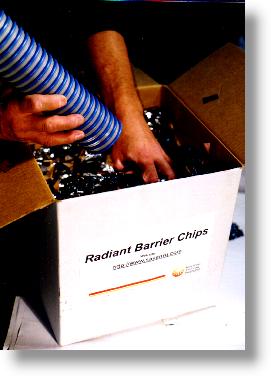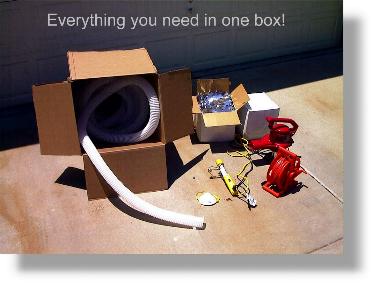Return To Home Page
Arizona
Insulation vs. radiant barrier: Which is best?
Actually, you need both, but read below what we learned on two identical test homes built side by side in 1986 in Phoenix Arizona.
RBS HOME
The RBS home had no insulation, only radiant barrier in the walls and
ceiling. NOTE: This was prior to the manufacturing
of the RBS Chips so only sheet type RBS was used for this
experiment.
CONVENTIONAL HOME
The other home had R-19 batt walls and R-30 blown fiberglass in
the attic. This home was occupied by a couple who both worked during
the day so the house was empty. The RBS home was occupied by a
family of seven. Data collection was set up by Dr. Byard Wood of ASU who
installed 15 thermocouples in each home to monitor temperatures every 10 minutes
of attic, ceiling, roof, duct, interior, and ambient temperatures. Testing
began in the winter of 1986 and continued 24/7 until late summer 1987.
This is where we discovered the potential insulation has for storing and re-emitting heat into the home.
FACTS:
The
attic temperature in the RBS home was never more than a few degrees above the
outdoor temperature while the insulation house was over 145f every summer
day. Discussions with Dr. Wood followed regarding the low temperature of
the RBS attic and was suggested that the lack of insulation was cooling the
attic. Each home was then fitted with two KWH meters, (image here), one for each heat
pump. These meters showed a 35% reduction of energy needed for cooling and
the home was more comfortable. Further, the RBS house was unoccupied
during the day by a family of seven while the insulation house was occupied by a
working couple who turned the thermostat up to 85 when they left for work each
day. Despite these obvious disparities in the test, the RBS house was more
comfortable and returned 35% savings over the identical home next door with
convention insulation.
Late summer it was decided to add blown attic insulation to the RBS home to reduce the noise from the busy street the homes were built on. Just hours after the insulation was installed the attic temperature in the RBS home was hotter than it had ever been. Further, the attic stayed hotter longer after the sun went down as compared the RBS only attic.
![]()
Installing RBS Chips yourself ![]()
 A box of RBS Chips and the feed hose
A box of RBS Chips and the feed hose

RBS
Chips being blown in the attic

We will ship you everything
you need to do the installation yourself:
Click your back button to return or
click here
Visit
our main page click here.
Click here to email us for more information
or brochures on our products.
![]()

![]()
Web page design and maintained by B Rad Design Group
Copyright 1997-2014 Horizon Energy Systems. All rights reserved
and
all violators will be prosecuted.
Information in this document is subject to change
without notice. Other
products and companies referred to herein are trademarks or
registered trademarks of their respective companies or mark
holders.